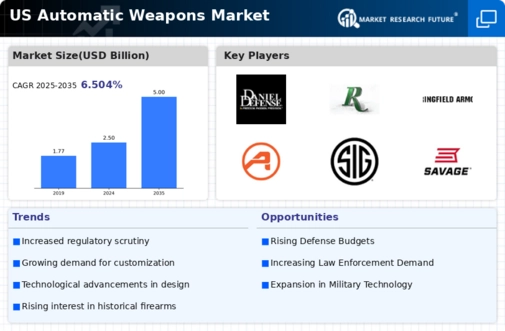Civilian Market Expansion
The automatic weapons market is witnessing a notable expansion in the civilian sector, driven by a growing interest in personal defense and recreational shooting. Recent surveys indicate that approximately 30% of US households own firearms, with a significant portion expressing interest in automatic weapons for self-defense and sport shooting. This trend is further supported by the increasing number of shooting ranges and training facilities, which cater to civilian users. Moreover, the market for automatic weapons is projected to grow at a CAGR of around 4% over the next five years, reflecting a rising acceptance of these firearms among civilians. As manufacturers respond to this demand with innovative products and customization options, the automatic weapons market is likely to experience a diversification of its consumer base, leading to increased sales and market penetration.
Technological Integration
The automatic weapons market is significantly impacted by the integration of advanced technologies into weapon systems. Innovations such as smart targeting systems, enhanced accuracy features, and modular designs are becoming increasingly prevalent. This technological evolution is not only improving the performance of automatic weapons but also attracting interest from both military and civilian sectors. For instance, the incorporation of AI and machine learning in weapon systems is expected to enhance operational efficiency and decision-making processes. As a result, manufacturers are investing heavily in research and development to stay competitive in this rapidly evolving landscape. The automatic weapons market is likely to benefit from these advancements, as consumers seek cutting-edge solutions that offer improved functionality and reliability. This trend suggests a future where technology plays a pivotal role in shaping the capabilities of automatic weapons.
Rising Law Enforcement Needs
The automatic weapons market is also influenced by the rising needs of law enforcement agencies across the US. With increasing concerns over public safety and crime rates, police departments are investing in more advanced weaponry to effectively address threats. Reports indicate that law enforcement budgets have increased by approximately 5% annually, with a portion allocated specifically for automatic weapons and tactical gear. This trend suggests a growing recognition of the necessity for law enforcement to be equipped with modern firearms capable of handling high-risk situations. Additionally, the ongoing discussions around police reform and community safety may further drive demand for automatic weapons, as agencies seek to balance effective response capabilities with public accountability. Consequently, the automatic weapons market is likely to see sustained growth as law enforcement agencies continue to modernize their arsenals.
Evolving Regulatory Landscape
The automatic weapons market is navigating an evolving regulatory landscape that influences market dynamics. Recent legislative changes at both state and federal levels have introduced new requirements for the sale and ownership of automatic weapons. For example, certain states have implemented stricter background checks and licensing processes, which may impact consumer access to these firearms. However, this regulatory scrutiny also presents opportunities for manufacturers to develop compliant products that meet legal standards. As the market adapts to these changes, there may be a shift in consumer preferences towards automatic weapons that align with regulatory requirements. This evolving landscape indicates that while challenges exist, there is potential for growth as manufacturers innovate to meet both consumer demands and regulatory expectations.
Increased Military Expenditure
The automatic weapons market is experiencing a notable surge due to increased military expenditure by the US government. In recent years, defense budgets have seen a consistent rise, with allocations for advanced weaponry and technology enhancements. For instance, the US Department of Defense has earmarked approximately $700 billion for military spending in 2025, which includes significant investments in automatic weapons systems. This trend indicates a robust demand for modernized weaponry, as military forces seek to enhance their operational capabilities. Furthermore, the focus on counter-terrorism and national security has led to a prioritization of advanced automatic weapons, thereby driving growth in the market. As military contracts expand, manufacturers are likely to benefit from increased production and innovation, further solidifying the automatic weapons market's position within the defense sector.

















Leave a Comment